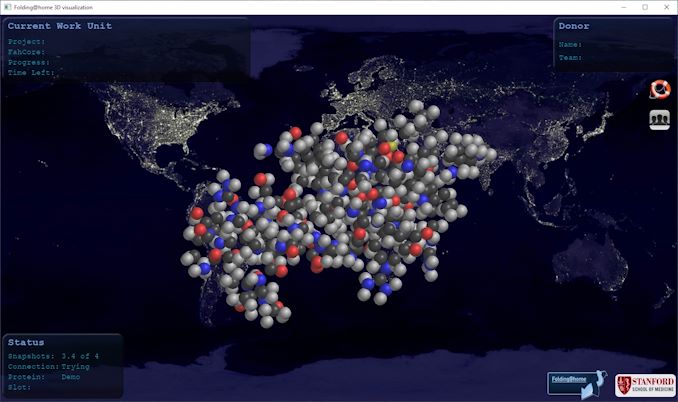Folding@Home Reaches Exascale: 1,500,000,000,000,000,000 Operations Per Second for COVID-19
by Anton Shilov on March 26, 2020 6:00 AM EST- Posted in
- Distributed Computing
- Exascale
- Coronavirus
- Folding@Home

Folding@home has announced that cumulative compute performance of systems participating in the project has exceeded 1.5 ExaFLOPS, or 1,500,000,000,000,000,000 floating point operations per second. The level of performance currently available from Folding@home participants is by an order of magnitude higher than that of the world’s most powerful supercomputer.
Right now, cumulative performance of active CPUs and GPUs (which have returned Work Units within the last 50 days) participating in the Folding@home project exceeds 1,5 ExaFLOPS, which is 10 times faster than performance of IBM’s Summit supercomputer benchmarked for 148.6 PetaFLOPS. To get there, Folding@Home had to employ 4.63 million CPU cores as well as nearly 430 thousand GPUs. Considering the nature of distributed computing, not all CPU cores and GPUs are online at all times, so performance available for Folding@home projects varies depending on availability of hardware.
| Folding@home Active CPUs & GPUs Reported on Wed, 25 Mar 2020 23:04:31 GMT |
||||||||
| AMD GPUs | NVIDIA GPUs | CPUs | CPU Cores | TFLOPS | x86 TFLOPS | |||
| Windows | 75,823 | 314,952 | 474,277 | 3,588,315 | 680,371 | 1,384,998 | ||
| Linux | 3,675 | 41,113 | 78,124 | 811,997 | 85,028 | 167,152 | ||
| macOS | - | - | 41,582 | 230,198 | 2,578 | 2,578 | ||
| Total | 79,498 | 356,065 | 593,983 | 4,630,510 | 767,977 | 1,554,728 | ||
| Note: | CPUs and GPUs which have returned Work Units within the last 50 days are considered Active. | |||||||
The outbreak of COVID-19 has been taxing for a number of computational biology and chemistry projects. IBM recently formed its COVID-19 High Performance Computing Consortium that pools together major supercomputers run by various research institutions and technology companies in the USA to run research simulations in epidemiology, bioinformatics, and molecular modeling. Cumulative performance of supercomputers participating in IBM’s COVID-19 HPC Consortium is 330 PetaFLOPS.
Folding@home distributed computing project uses compute capabilities to run simulations of protein dynamics in a bid to better understand them and find cures for various diseases. Recently F@H started to run projects simulating theoretically druggable protein targets from SARS-CoV-2, which attracted a lot of attention as SARS-CoV-2 and COVID-19 are clearly the hottest topics these days.
We at AnandTech also have our Folding@Home team, which are currently in a race against our sister site Tom's Hardware. If you have a GPU spare that's not too old, think about joining us in our battle. We are Team 198.
Related Reading:
- IBM & Partners to Fight COVID-19 with Supercomputers, Forms COVID-19 HPC Consortium
- Help Fight COVID-19 and Tom's Hardware: Join The Great Folding@Home Coronavirus Race
Source: Folding@Home Twitter










71 Comments
View All Comments
djht - Friday, March 27, 2020 - link
more like Botnet@Home...d0x360 - Friday, March 27, 2020 - link
That's great but the servers are so overloaded it can take hours just to send your results when you finish and hours to get a new set of data and if it takes too long to send your finished calculations they become invalid so you have wasted hours of time letting your PC do the work and hours waiting for new work only for it to be all for nothing.. sighThreska - Monday, March 30, 2020 - link
Lets thank gamers for indirectly bringing about the need for all this horsepower.danwat1234 - Saturday, October 9, 2021 - link
How sad! The project's computational power has been greatly diminished since then it seems. Although the chart says based off the last 3 days of active hosts instead of last 50..?Only about 75,000 active CPUs into 30,000 active GPUs?
Do they have enough computational power for what scientists want right now? Stop cryptocurrency mining, start crunching for science!
https://statsclassic.foldingathome.org/os